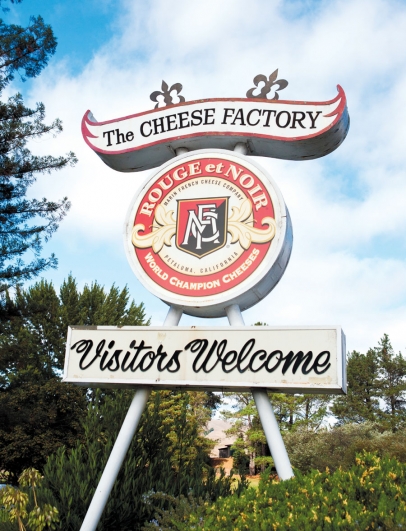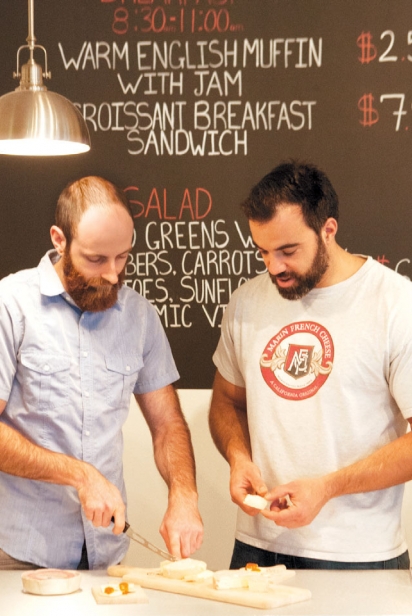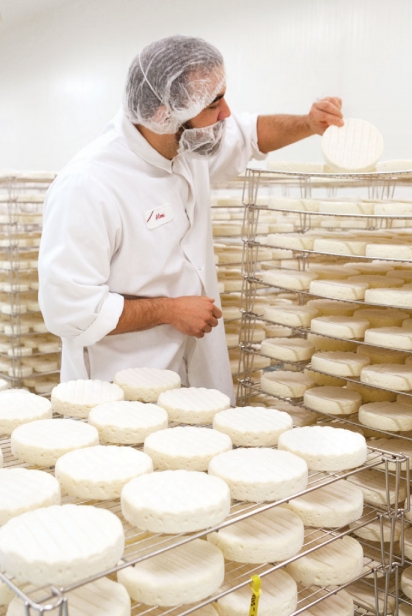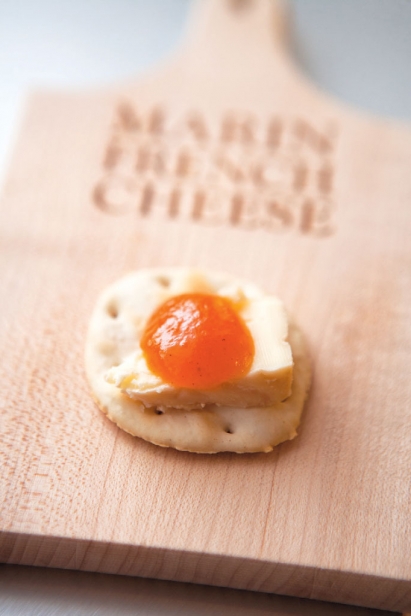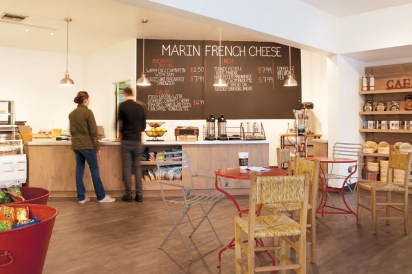Marin French Cheese Turns 150
Oldest Continuously Operating Cheese Factory in the Country
Why would you ride barefoot in a wagon train from Illinois to California? Or would you?
Jefferson Thompson did just that in the late 1850s, leaving his cheesemaking family in Illinois and traveling for eight months to the “wild West” in a covered wagon, with cold feet and frostbitten toes.
Thompson’s logic was that by traveling barefoot, he could save his good pair of shoes for when he arrived at his new home.
The cheese factory Thompson eventually established here, Marin French Cheese, celebrates 150 years this year, making it the oldest continuously operating creamery in the United States. French cheesemakers visiting to celebrate the anniversary marveled that “even in France we would consider a 150-year-old cheese factory old. Remarkable.”
The Miwoks once called western Marin County their home before the Spanish showed up and took their land. The Californios arrived in the 1820s, after which General Mariano Vallejo issued a land grant known as Rancho Corte Madera de Novato. In 1839, Rafael Garcia established Rancho Baulines in Olema Valley and gave it to his sister and brother-in-law, Ramona and Gregorio Briones.
The “Americans” took over what is now Marin County in 1846.
Jefferson Thompson bought the site of what was to become Marin French Cheese, a 700-acre dairy ranch in Hicks Valley known as one of the ranchos grandes, for a rumored $5,000. The site is a bucolic soil-rich sunny dip between hills where the current Petaluma-Point Reyes roads and Nicasio Boulevard intersect nine miles north of Nicasio and about nine miles west of Petaluma.
Not yet having any milking cows of his own, Thompson set about visiting neighboring dairy ranches, making new friends and taking what was left after they made butter, and created a granular “bar cheese,” known then as a sideline to the butter trade.
Thompson sent his bar cheese by horse-drawn wagon to the steamer Gold docked in Petaluma, which ferried it down the Petaluma River and across the Bay to Yerba Buena, now known as San Francisco. His Yellow Buckbrand cheese was then sold as a staple, along with pickled eggs, in saloons at Yerba Buena Cove when Montgomery Street was the waterfront.
In 1897, Jefferson Thompson Jr. (“Jeff ”) and his brother Rudolph took over as the next generation of cheesemakers. Jeff had studied cheesemaking under Swiss-born Petaluma Camembert maker Louis Cantel, who never revealed his ultimate secrets to making the best “French” Camembert in the West. Cantel primarily sold his cheese to the French community in San Francisco.
Partly out of frustration with his mentor’s secrecy and partly because the federal government had suggested that American cheesemakers learn to replicate soft European cheeses, Jeff eventually enrolled in the University of Connecticut at Storrs to study cheesemaking. On his return to Hicks Valley, the Thompsons started to make Camembert, Brie, Neufchatel, Double Cream and Breakfast Cheese.
As the family story goes, fellow Petaluma Elks Club members ribbed Jeff and Rudolph about using the old Yellow Buck label on these new French-style cheeses. One pre-1906-earthquake evening at an after-theatre party at the Ritz Old Poodle Dog restaurant in San Francisco, friend and newsman Jack Donagan queried, “Why not a French name?” Thereafter, “Rouge et Noir” replaced the Yellow Buck label.
From 1919 to 1933, Prohibition dried up the saloons in San Francisco, along with their free lunches and cheese sales to the dockworkers and their friends. But the loyal imbibers didn’t forget the Thompsons’ good cheeses.
Largely because of Rouge et Noir, Marin County became the largest producer of cheese in California around 1926.
Pierce ( Jeff ’s son) and his cousin Ed Thompson (both grandsons of founder Jefferson Thompson) took over management of Marin French in 1942. Ed had grown up on the ranch and never lived anywhere else. The January 10, 1979, edition of the San Francisco Examiner reported that Ed recalled that in the 1930s all the family worked at the cheese factory but no one got paid. He said he was put on the payroll in 1938. Before that, he was living and working on the property, and offered “We got all our food, clothes and fishing line. Hell, what else do we need?”
Pierce was born and raised in Petaluma, studied dairy at UC Davis, and graduated from UC Berkeley. His children, Robert and Marilyn Thompson, grew up working summers and after school packing cheese and slicing wood for cheese packages. If they were hungry, the “kids” always had to pay for their cheese they recalled. Both (perhaps understandably) followed careers outside the cheese business. Still living in the area, Robert is a building engineer and Marilyn is a music professor and professional pianist.
When soldiers came back from Europe after World War II having tasted Brie, Camembert and other soft cheeses there, the demand for soft European-style cheeses increased. Having taken the government’s prescient advice, Marin French was ready to meet the need.
The factory’s production plant was enlarged three times in the decade from 1969 to 1979. But in the meantime, in 1972, Pierce and Ed Thompson turned management over to Ed’s adopted son, Doug Johnstone (son of Ed’s wife Charlotte’s sister), and nephew David Brooks.
In 1979, Marin County officials ranked Marin French as the number three tourist attraction in the county, behind Muir Woods and the Frank Lloyd Wright–designed Marin Civic Center.
Doug was in charge of sales and David served as head cheesemaker in early ’80s, when all cheese businesses nationwide suffered a blow as the public seemed to suddenly wake up to the fact that cheese contains fat, at the time a real “no no” among health advocates.
In 1998, the Thompson family sold the company to organic cattle rancher and developer Jim Boyce and his first wife, Chris. Boyce, a resident of Bishop, California, was a principled mover and shaker with expansive ideas who had put together all the land deals to make up Disney World in Florida.
As Boyce’s second wife, lifelong friend and widow Kris told Congressman Jared Huffman at the January luncheon that celebrated the cheese factory’s 150th anniversary, “The real estate person told Jim he had a perfect piece of land for him, but the only trouble was that it had a cheese factory on it.”
Boyce saw that as a new opportunity and threw his substantial financial ability and charm into developing new cheeses and marketing them. He increased the company’s cheese offerings from five to 40 varieties, including quarks, flavored Brie and blue cheese, and he and the crew started to make cow, goat and mélange cheeses.
Boyce believed the company’s cheese was excellent and that it just needed more exposure—to consumers and also to cheese judges. To accomplish that, he modernized the plant and got the cheeses into Costco and other big-box stores, but never at the expense of quality or traditional methodology.
He also hired Alex Borgo, a young third-generation cheesemaker with roots in Italy, Germany and Canada. Alex began making cheese in the family business at the age of 10, and, after earning his business management degree and a brief career as a professional baseball player, returned to his first love, studying and making cheese in Canada and Europe before coming to Marin French. Borgo now leads the cheesemaking team at Marin French.
At the invitation of the California Milk Advisory Board, Kris and Jim Boyce traveled the world as California cheese ambassadors and developed sales in South Korea, South Africa and Saudi Arabia. According to Marin French's Lynne Devereux, “Jim competed in every contest. We so welcomed his spirit and camaraderie.”
As such, Boyce played an important role in the rebirth of cheesemaking in Northern California, believing in “terroir,” or the sense of place that comes from where something is produced.
And the awards started to flow. Marin French’s Triple Crème Brie won a gold medal in the pasteurized milk brie category at the World Cheese Awards in London in 2005. Boyce thought winning gold at the World Cheese Awards was equal to Stags’ Leap’s 1973 Cabernet Sauvignon besting French wines at the 1976 “Judgment of Paris.” The company also won Best American Cheese for its Yellow Buck Chèvre Goat’s Milk Camembert in the same year.
When Boyce passed away in 2010, his estate sold Marin French Cheese to Rians, a French cheese company that had previously purchased Sonoma’s iconic Laura Chenel’s Chèvre.
No newcomer to making fine cheeses itself, Marin French Cheese landed in expert hands with Rians, and the awards continue to flow. At the 2014 World Cheese Awards, Marin French Cheese won super gold for its Supreme, silver for its Schloss and bronze for its Triple Crème Brie.
It’s come a very long way, baby, in just 150 years.
Marin French Cheese cheeses are available at the factory, 7510 Point Reyes– Petaluma Road, Petaluma, at retail locations nationwide and online at MarinFrenchCheese.com. The recently renovated factory store, deli and picnic grounds are open daily 8:30am–5pm, closed major holidays.
Kathleen Thompson Hill is food and wine editor of the Sonoma Index-Tribune, co-author of a series of guide books to wine regions of the West Coast, culinary historian and host of the “Kathleen Hill Show” on KSVY.


